Improved Model-Free Adaptive Predictive Control for Nonlinear Systems with Quantization Under Denial of Service Attacks
Abstract
1. Introduction
- Network bandwidth limitation and DoS attacks are handled simultaneously for nonlinear systems only utilizing the I/O data to design control methods. The proposed IMFAPC method can eliminate the dependence on the system model, which is a data-driven control method.
- An attack compensation mechanism is presented to reduce the impact of the DoS attacks on the control system, which can be adjusted according to the different attack strategies of attackers, and the elastic control of the DoS attack can be realized for systems with different complexity and attack intensity.
- A uniform quantizer with encoding and decoding mechanisms is proposed to settle the network bandwidth limitation and to reduce the effects of quantization errors. Furthermore, the convergence analysis of the proposed control method is carried out, and the tracking error is proved to be bound.
2. Problem Formulation
2.1. DoS Attacks
2.2. Prediction Equation
2.3. Uniform Quantizer and Encoding and Decoding Mechanism
3. Control Algorithm Design and Analysis
| Algorithm 1: IMFAPC Design for network bandwidth limitation and DoS attacks |
|
4. Simulation Study
4.1. Without Disturbance
4.2. With Disturbance
5. Conclusions
Author Contributions
Funding
Data Availability Statement
Acknowledgments
Conflicts of Interest
References
- Hou, Z.S.; Xu, J.X. On data-driven control theory: The state of the art and perspective. Acta Autom. Sin. 2009, 35, 650–667. [Google Scholar] [CrossRef]
- Hou, Z.S.; Chi, R.; Gao, H. An overview of dynamic-linearization-based data-driven control and applications. IEEE Trans. Ind. Electron. 2017, 64, 4076–4090. [Google Scholar] [CrossRef]
- Hou, Z.; Gao, H.; Lewis, F.L. Data-driven control and learning systems. IEEE Trans. Ind. Electron. 2017, 64, 4070–4075. [Google Scholar]
- Hjalmarsson, H.; Gunnarsson, S.; Gevers, M. A Convergent Iterative Restricted Complexity Control Design Scheme. In Proceedings of the 33rd IEEE Conference on Decision and Control, Lake Buena Vista, FL, USA, 14–16 December 1994; pp. 1735–1740. [Google Scholar]
- Guardabassi, G.; Savaresi, S. Virtual reference direct design method: An off-line approach to data-based control system design. IEEE Trans. Automat. Contr. 2000, 45, 954–959. [Google Scholar] [CrossRef]
- Liu, G.; Hou, Z. Adaptive iterative learning fault-tolerant control for state constrained nonlinear systems with randomly varying iteration lengths. IEEE Trans. Neural. Networ. 2024, 35, 1735–1749. [Google Scholar] [CrossRef] [PubMed]
- Hou, Z.; Xiong, S. On model-free adaptive control and its stability analysis. IEEE Trans. Automat. Contr. 2019, 64, 4555–4569. [Google Scholar] [CrossRef]
- Liu, S.; Li, Z.; Ji, H.; Hou, Z.; Chen, L. Data learning-based model-free adaptive control and application to an NAO robot. Int. J. Robust Nonlinear Control 2023, 33, 2722–2747. [Google Scholar] [CrossRef]
- Liu, G.; Hou, Z.S. Cooperative adaptive iterative learning fault-tolerant control scheme for multiple subway trains. IEEE Trans. Cybern. 2022, 52, 1098–1111. [Google Scholar] [CrossRef]
- Liu, G.; Hou, Z.S. RBFNN-based adaptive iterative learning fault-tolerant control for subway trains with actuator faults and speed constraint. IEEE Trans. Syst. Man Cybern. Syst. 2021, 51, 5785–5799. [Google Scholar] [CrossRef]
- Hou, Z.; Jin, S. Model Free Adaptive Control: Theory and Applications; CRC Press: Boca Raton, FL, USA, 2013. [Google Scholar]
- Bu, X.; Hou, Z.; Zhang, H. Data-driven multiagent systems consensus tracking using model free adaptive control. IEEE Trans. Neural. Networ. 2018, 29, 1514–1524. [Google Scholar] [CrossRef]
- Bu, X.; Yu, W.; Yu, Q.; Hou, Z.; Yang, J. Event-Triggered Model-Free Adaptive Iterative Learning Control for a Class of Nonlinear Systems Over Fading Channels. IEEE Trans. Cybern. 2022, 52, 9597–9608. [Google Scholar] [CrossRef] [PubMed]
- Zhu, P.; Jin, S.; Bu, X.; Hou, Z.; Yin, C. Model-free adaptive control for a class of MIMO nonlinear cyberphysical systems under false data injection attacks. IEEE Trans Control Netw Syst. 2023, 10, 467–478. [Google Scholar] [CrossRef]
- Zheng, J.; Hou, Z. ESO-Based Model-Free Adaptive Iterative Learning Energy-Efficient Control for Subway Train with Disturbances and Over-Speed Protection. IEEE Trans. Intell. Transp. Syst. 2023, 24, 8136–8148. [Google Scholar] [CrossRef]
- Liu, S.; Hou, Z.; Tian, T.; Deng, Z.; Guo, L. Path tracking control of a self-driving wheel excavator via an enhanced data-driven model-free adaptive control approach. IET Control Theory Appl. 2020, 14, 220–232. [Google Scholar] [CrossRef]
- Han, T.; Zhu, H.; Yu, D. Data-Driven Model Predictive Control for Uncalibrated Visual Servoing. Symmetry 2024, 16, 48. [Google Scholar] [CrossRef]
- Jin, S.; Hou, Z.; Chi, R.; Bu, X. Model free adaptive predictive control approach for phase splits of urban traffic network. In Proceedings of the 2016 Chinese Control and Decision Conference (CCDC), Yinchuan, China, 28–30 May 2016; pp. 5750–5754. [Google Scholar]
- Guo, Y.; Hou, Z.; Liu, S.; Jin, S. Data-driven model-free adaptive predictive control for a class of MIMO nonlinear discrete-time systems with stability analysis. IEEE Access 2019, 7, 102852–102866. [Google Scholar] [CrossRef]
- Hespanha, J.; Naghshtabrizi, P.; Xu, Y. A Survey of Recent Results in Networked Control Systems. Proc. IEEE 2007, 95, 138–162. [Google Scholar] [CrossRef]
- Li, H.; Sun, Z.; Sun, F. Networked control systems: An overview of state-of-the-art and the prospect in future research. Control Theory Appl. 2010, 27, 238–243. [Google Scholar]
- Zhang, X.M.; Han, Q.L.; Yu, X. Survey on Recent Advances in Networked Control Systems. IEEE Trans. Ind. Inform. 2016, 12, 1740–1752. [Google Scholar] [CrossRef]
- Schlotterbeck, C.; Gallegos, J.A.; Teel, A.R.; Núñez, F. Stability guarantees for a class of networked control systems subject to stochastic delays. IEEE Trans. Automat. Contr. 2024, 69, 8884–8891. [Google Scholar] [CrossRef]
- Zhang, W.-A.; Yu, L. Modeling and control of networked control systems with both network-induced delay and packet-dropout. Automatica 2008, 44, 3206–3210. [Google Scholar] [CrossRef]
- Li, T.; Xie, L. Distributed Coordination of Multi-Agent Systems with Quantized-Observer Based Encoding-Decoding. IEEE Trans. Automat. Contr. 2012, 57, 3023–3037. [Google Scholar] [CrossRef]
- Jiang, K.; Mao, L.; Su, Y.; Zheng, Y. Trajectory Tracking Control for Underactuated USV with Prescribed Performance and Input Quantization. Symmetry 2021, 13, 2208. [Google Scholar] [CrossRef]
- Wang, J. Quantized Feedback Control of Discrete-Time MIMO Linear Systems with Input and Output Quantization Over Finite Data Rate Channels. IEEE Trans. Automat. Contr. 2023, 68, 6277–6284. [Google Scholar] [CrossRef]
- Bu, X.; Cheng, Z.; Hou, Z. Iterative learning control for discrete-time systems with quantised measurements. IET Control Theory Appl. 2015, 9, 1455–1460. [Google Scholar] [CrossRef]
- Shen, D.; Zhang, C. Zero-error tracking control under unified quantized iterative learning framework via encoding–decoding method. IEEE Trans. Cybern. 2022, 52, 1979–1991. [Google Scholar] [CrossRef] [PubMed]
- Bu, X.; Qiao, Y.; Hou, Z.; Yang, J. Model Free Adaptive Control for a Class of Nonlinear Systems Using Quantized Information. Asian J. Control 2018, 20, 962–968. [Google Scholar] [CrossRef]
- Zhu, P.; Bu, X.; Liang, J.; Shen, D. Data driven control for a class of nonlinear SISO systems with uniform quantizer using encoding and decoding mechanism. In Proceedings of the 2019 IEEE 8th Data Driven Control and Learning Systems Conference (DDCLS), Dali, China, 24–27 May 2019; pp. 7–12. [Google Scholar]
- Liu, G.; Hou, Z. Quantized data driven model-free adaptive predictive control for a class of nonlinear systems. In Proceedings of the 2023 IEEE 12th Data Driven Control and Learning Systems Conference (DDCLS), Xiangtan, China, 12–14 May 2023; pp. 1105–1110. [Google Scholar]
- Ren, H.; Liu, R.; Cheng, Z.; Ma, H.; Li, H. Data-Driven Event-Triggered Control for Nonlinear Multi-Agent Systems with Uniform Quantization. IEEE Trans. Circuits Syst. II Express Briefs 2024, 71, 712–716. [Google Scholar] [CrossRef]
- Ma, Y.; Che, W.; Deng, C.; Wu, Z. Distributed Model-Free Adaptive Control for Learning Nonlinear MASs Under DoS Attacks. IEEE Trans. Neural. Networ. 2023, 34, 1146–1155. [Google Scholar] [CrossRef]
- Wan, K.; Chen, Y.; Zhao, J.; Yu, M. Event-triggered secure consensus control for DC microgrids under DoS attacks. IEEE Trans. Ind. Electron. 2024, 72, 908–918. [Google Scholar] [CrossRef]
- Tan, C.; Di, J.; Guo, G.; Li, Y.; Wong, W.S. Exponential mean-square stabilization control for cyber-physical systems under random DoS attacks and transmission delay. IEEE Trans. Automat. Contr. 2024, 70, 190–202. [Google Scholar] [CrossRef]
- Xu, X.; Luo, H.; Chen, W.; Gao, L. Containment Control Problem of Linear Multiagent Systems with External Disturbance and DoS Attacks. Symmetry 2023, 15, 384. [Google Scholar] [CrossRef]
- Zhao, N.; Shi, P.; Xing, W.; Lim, C.P. Event-triggered control for networked systems under denial of service attacks and applications. IEEE Trans. Circuits Syst. I Reg. Papers 2022, 69, 811–820. [Google Scholar] [CrossRef]
- Li, Y.; Lu, G.; Li, K. Fuzzy adaptive event-triggered consensus control for nonlinear multiagent systems with output constraints and DoS attacks. IEEE Trans. Cybern. 2024, 55, 2–13. [Google Scholar] [CrossRef]
- Tan, W.; Hou, Z.; Li, Y.X. Robust data-driven iterative learning control for high-speed train with aperiodic DoS attacks and communication delays. IEEE Trans. Intell. Vehicl. 2024, 1–10. [Google Scholar] [CrossRef]
- Bu, X.; Yu, W.; Yin, Y.; Hou, Z. Event-triggered data-driven control for nonlinear systems under frequency-duration-constrained DoS attacks. IEEE Trans. Inf. Forensic. Secur. 2023, 18, 1449–1460. [Google Scholar] [CrossRef]
- Hou, Z.; Jin, S. A novel data-driven control approach for a class of discrete-time nonlinear systems. IEEE Trans. Contr. Syst. Technol. 2011, 19, 1549–1558. [Google Scholar]
- Zhu, P.; Jin, S.; Bu, X.; Hou, Z. Improved model-free adaptive control for MIMO nonlinear systems with event-triggered transmission scheme and quantization. IEEE Trans. Cybern. 2023, 53, 5867–5880. [Google Scholar] [CrossRef]
- Huo, N.; Shen, D. Encoding–decoding mechanism-based finite-level quantized iterative learning control with random data dropouts. IEEE Trans. Autom. Sci. Eng. 2020, 17, 1343–1360. [Google Scholar] [CrossRef]
- Bu, X.; Zhu, P.; Yu, Q.; Hou, Z.; Liang, J. Model-free adaptive control for a class of nonlinear systems with uniform quantizer. Int. J. Robust Nonlinear Control 2020, 30, 6383–6398. [Google Scholar] [CrossRef]
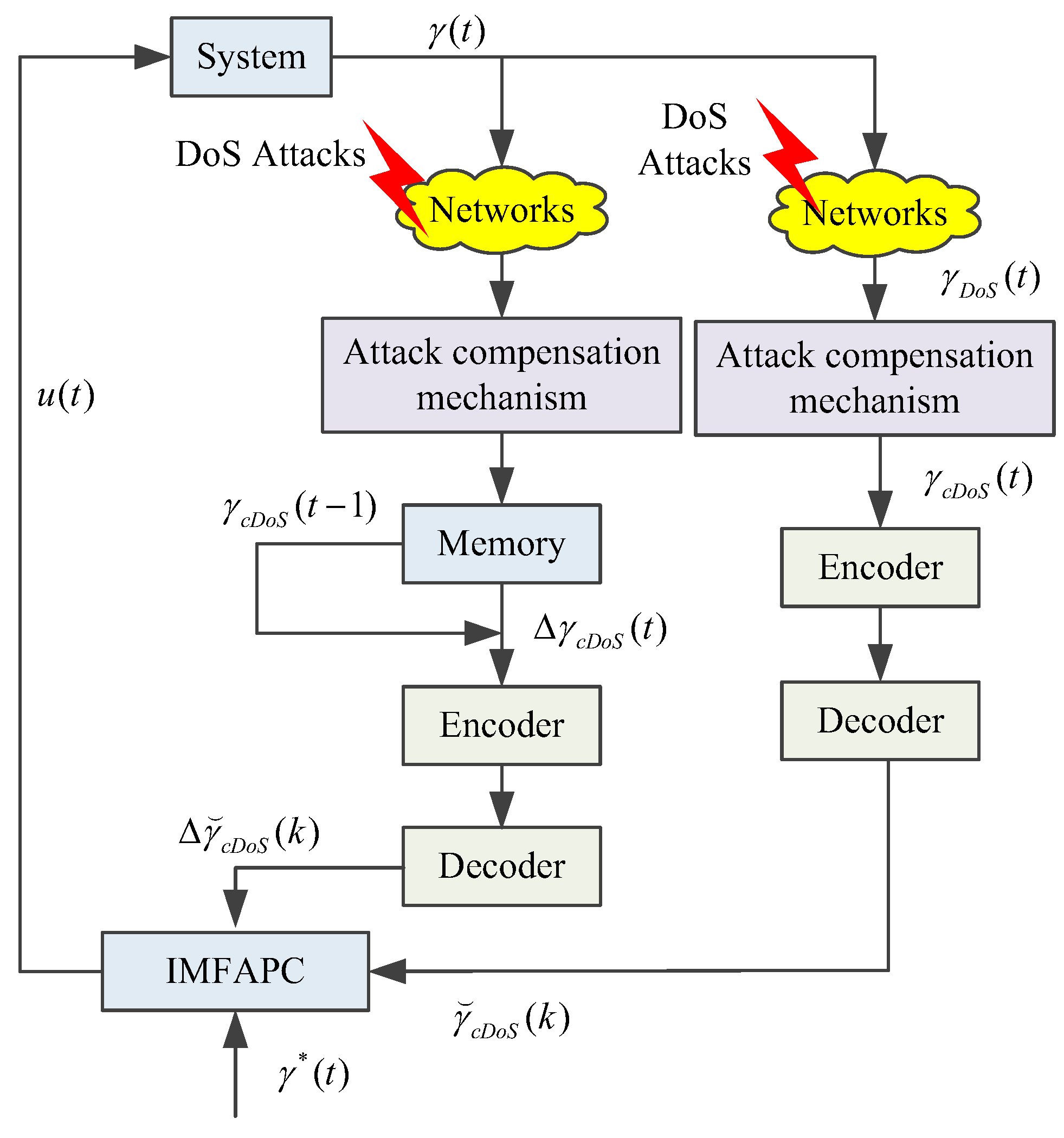

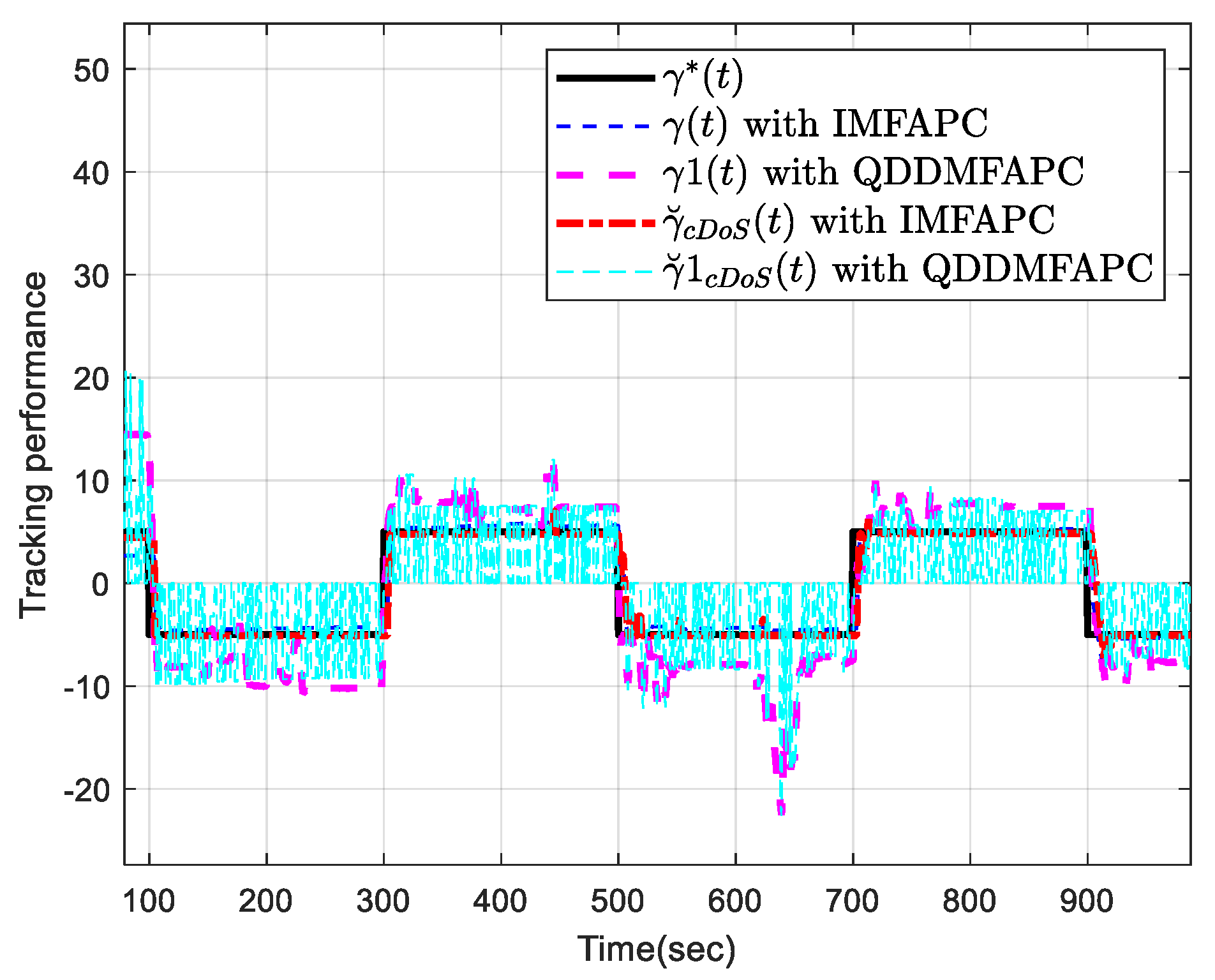
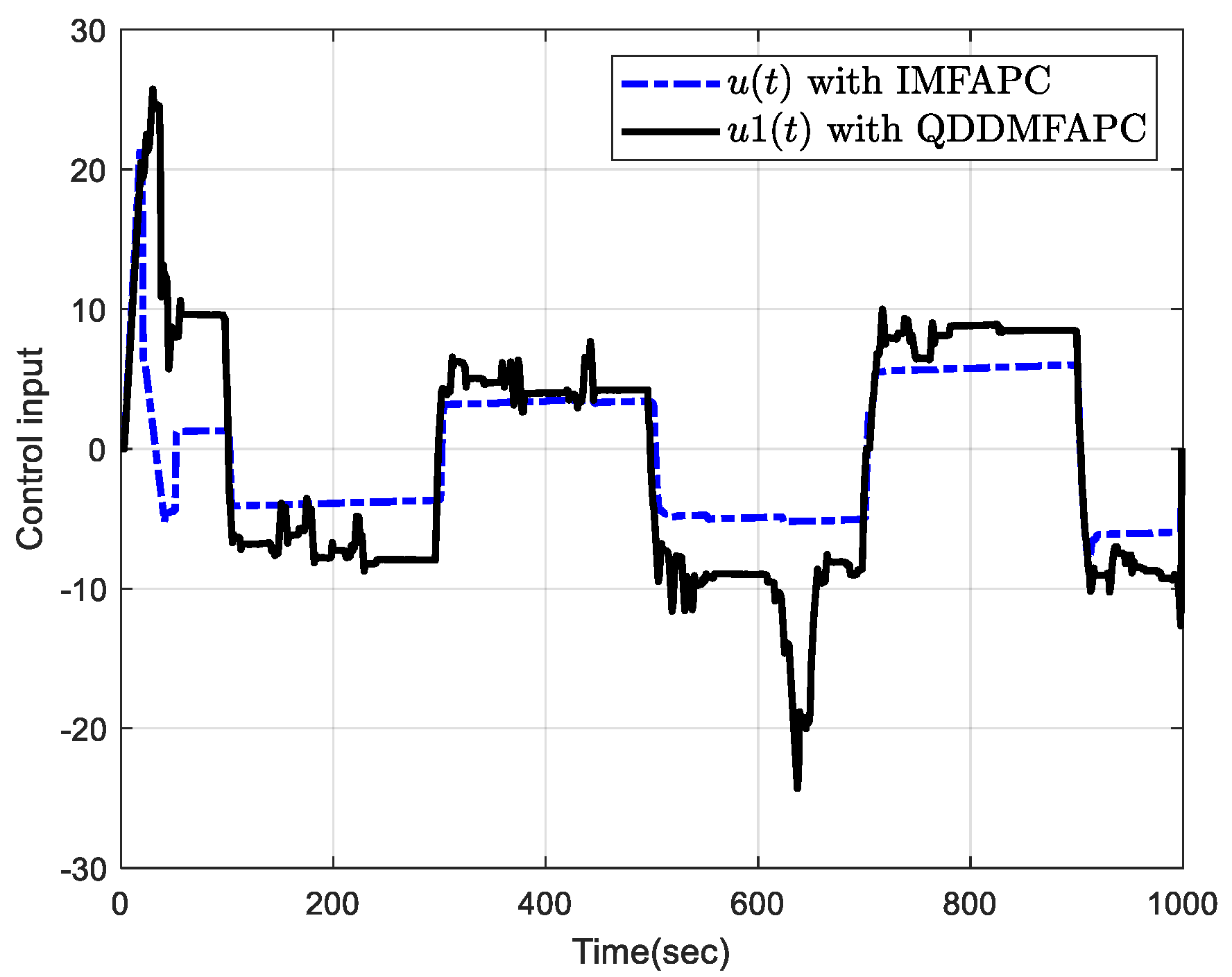
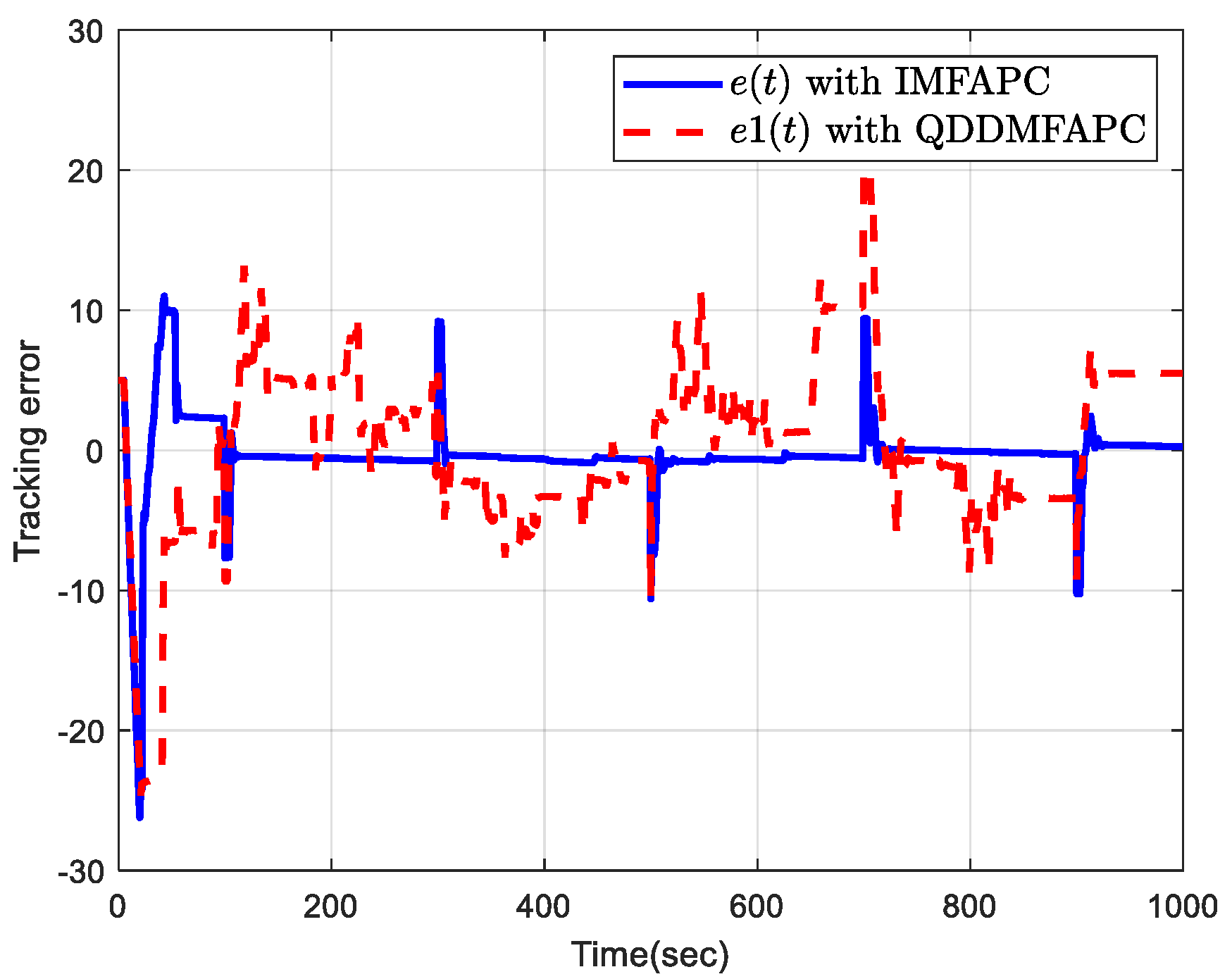


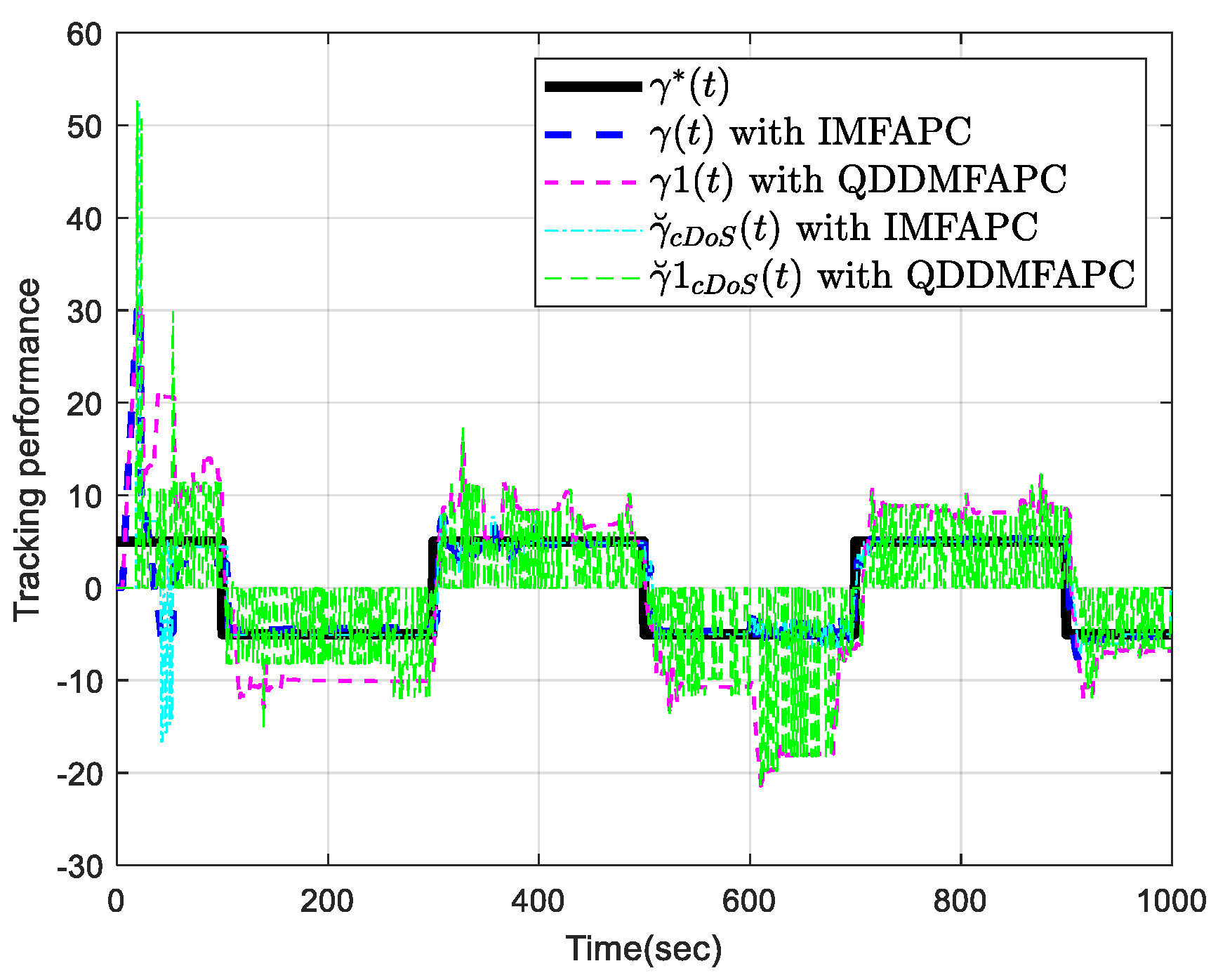

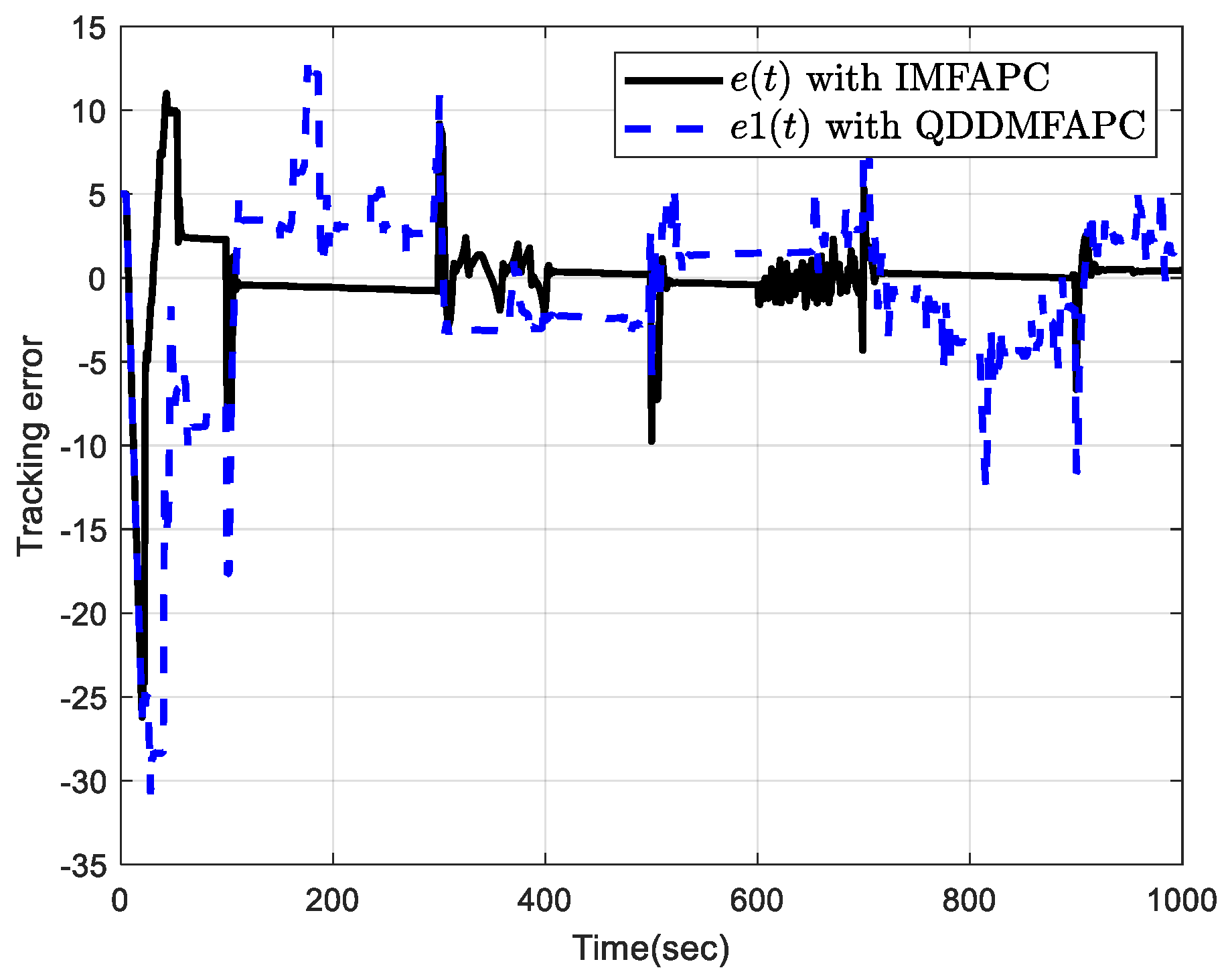
| Control Algorithm | Mean Tracking Error |
|---|---|
| IMFAPC | 0.0002 |
| QDDMFAPC | 0.0025 |
| Control Algorithm | Mean Tracking Error |
|---|---|
| IMFAPC | 0.0004 |
| QDDMFAPC | 0.0016 |
| Abbreviations/Notations | The Meaning of Abbreviations/Notations |
|---|---|
| DoS | denial of service |
| DDC | data-driven control |
| MFAC | model-free adaptive control |
| MFAILC | model-free adaptive iterative learning control |
| MFAPC | model-free adaptive predictive control |
| MIMO | multiple input multiple output |
| NCS | network control system |
| ILC | iterative learning control |
| IMFAPC | improved model-free adaptive predictive control |
| QDDMFAPC | quantized data driven model-free adaptive predictive control |
| t | time |
| system output | |
| system output under DoS attacks | |
| system input | |
| reference trajectory | |
| time varying parameter of the system |
Disclaimer/Publisher’s Note: The statements, opinions and data contained in all publications are solely those of the individual author(s) and contributor(s) and not of MDPI and/or the editor(s). MDPI and/or the editor(s) disclaim responsibility for any injury to people or property resulting from any ideas, methods, instructions or products referred to in the content. |
© 2025 by the authors. Licensee MDPI, Basel, Switzerland. This article is an open access article distributed under the terms and conditions of the Creative Commons Attribution (CC BY) license (https://creativecommons.org/licenses/by/4.0/).
Share and Cite
Liu, G.; Zhu, J.; Wang, Y.; Wang, Y. Improved Model-Free Adaptive Predictive Control for Nonlinear Systems with Quantization Under Denial of Service Attacks. Symmetry 2025, 17, 471. https://doi.org/10.3390/sym17030471
Liu G, Zhu J, Wang Y, Wang Y. Improved Model-Free Adaptive Predictive Control for Nonlinear Systems with Quantization Under Denial of Service Attacks. Symmetry. 2025; 17(3):471. https://doi.org/10.3390/sym17030471
Chicago/Turabian StyleLiu, Genfeng, Jinbao Zhu, Yule Wang, and Yangyang Wang. 2025. "Improved Model-Free Adaptive Predictive Control for Nonlinear Systems with Quantization Under Denial of Service Attacks" Symmetry 17, no. 3: 471. https://doi.org/10.3390/sym17030471
APA StyleLiu, G., Zhu, J., Wang, Y., & Wang, Y. (2025). Improved Model-Free Adaptive Predictive Control for Nonlinear Systems with Quantization Under Denial of Service Attacks. Symmetry, 17(3), 471. https://doi.org/10.3390/sym17030471






